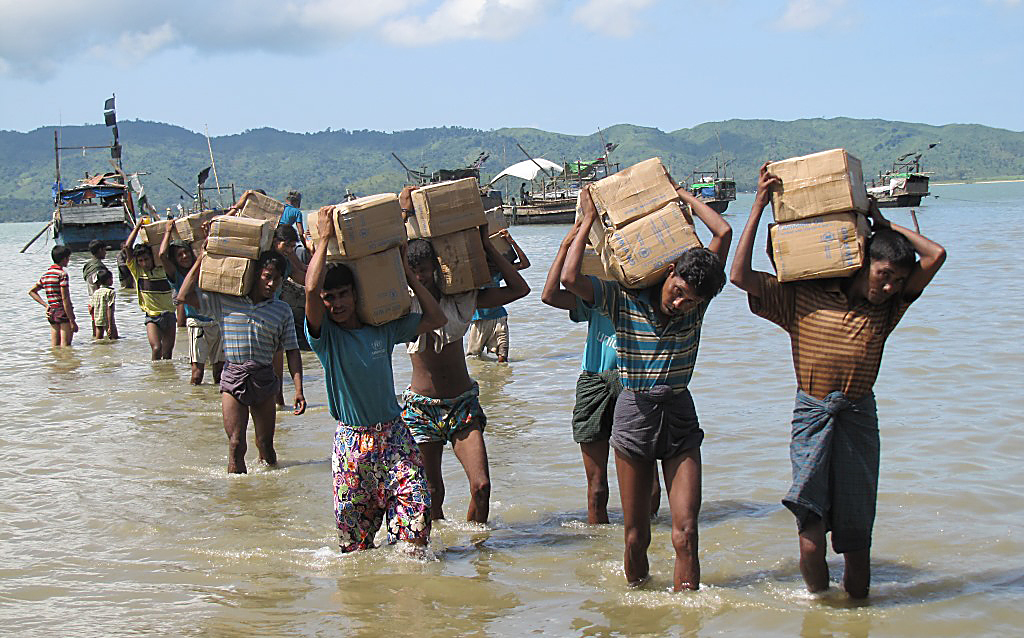The February 1 military coup in Myanmar is only the latest in a series of authoritarian reversals across the region. It follows a controversial declaration of a state of emergency in Malaysia in January, an ongoing authoritarian crackdown in Cambodia since 2017, and a military coup in Thailand in 2014. The other two countries of mainland Southeast Asia—Vietnam and Laos—defied early post-Cold War expectations by remaining single-party states. Yet the Southeast Asian region was regarded in the early 1990s as part of Huntington’s “third wave” of democracy, and as an exemplar of the supposedly causal relationship between rising incomes and democratic aspirations.
Southeast Asia’s status as a developmental success story is qualified by the historical legacies of violence and the contemporary reality of widespread development-induced displacement affecting the region. An analysis employing a broader perspective on well-being, focused on integral human development, recognizes that the evisceration of civil society across the region has produced political regimes based upon accumulation by dispossession, that deploy electoral democracy mainly as a tactical veneer for corrupt and oppressive strategies of rule.
The demands of the poor for a dignified share in the fruits of development have been largely ignored.
This line of argument rejects explanations that regard Southeast Asian politics as a product of great power influence. Such explanations are generally focused on the two major external powers in the region—the US and China. China’s influence in Southeast Asia has grown rapidly over the past twenty years following an exponential increase in Chinese investment. This has been driven by two interlinked objectives on China’s part: the need to secure sources of commodities, including minerals, energy, and plantation crops, and the desire to link its landlocked southwest to transport infrastructure, including through the Belt and Road Initiative. China’s interests in Southeast Asia, it has been argued, make it an “authoritarian gravity centre” in the region, exporting authoritarian modes of governance to neighboring regimes.
The US promoted formal democracy in the region (though it increased state surveillance of civil society after September 11th) before its influence waned following the election of Donald Trump in 2016 and the deterioration of US-China relations. This has raised fears that the influence of Chinese authoritarian developmentalism could undermine young democracies in places such as Thailand, Cambodia and Myanmar.
However, other observers familiar with the region agree that both Huntington’s “third wave” approach and recent concerns about great power rivalry underestimate the significance of internal features of the Southeast Asian context in explaining the fluctuating fortunes of democratic forms of rule in the region. Three features of mainland Southeast Asia are crucial for explaining the instability of political regimes in the region: the political legacies of massive violence during the colonial and Cold War eras; the dislocating impact of rapid economic development in the absence of an institutionalized politics of representation; and the acute vulnerability of the region to environmental degradation.
Historical context
From the 1950s to the 1980s, populations in Southeast Asia were subjected to massive violence associated with anti-colonial wars, communist insurgencies and foreign counter-insurgency intervention. The Malayan Emergency, the Indonesian mass killings of 1965, ethnic conflict in Myanmar, communist uprisings in the Philippines, the Khmer Rouge Revolution in Cambodia, and the Vietnam War saw the brutal killings of millions in the region, the razing of villages and cultural sites, the degradation of ecosystems and the disruption of agriculture, as well as dispossession on a massive scale. Post-colonial states were constructed around principles of ethnic management and manipulation, intrusive surveillance of the population and violent suppression of social movements representing the poor.
Because of the violence visited upon civil society, political settlements that have emerged across the region have tended to constitute elite pacts between business tycoons, military leaders and bureaucratic managers, largely unhampered by organized mechanisms of accountability to the poor. These elites have overseen the process of rapid capitalist development in the region since the late 1970s, with development schemes oriented around social service provision used as vehicles for mass patronage of key constituencies. As a consequence, modes of governance in Southeast Asia during the Cold War consolidated around the interests of regional and global capital, with the demands of the poor for a dignified share in the fruits of development largely ignored.
For those outside the region, there are important opportunities for solidarity.
Indeed, contemporary regional experience sharply calls into question narratives of “developmental success” that have become routinely applied to Southeast Asia since the 1980s. Recent strategies of development have themselves prompted social dislocation. Although Southeast Asia’s progress on poverty, measured against the World Bank’s $1.90 a day poverty line, has been impressive, basic metrics of GDP growth and cash incomes fail to comprehend the complexity of socioeconomic effects. An approach focused on integral human development would expand this analysis to highlight the social and cultural cost of mass urbanization, rising inequality and continued rural dispossession and stagnation.
Furthermore, integration into the global economy has brought repeated economic shocks, from the Asian financial crisis of 1997, to the global financial crisis of 2008, to the COVID-19 crisis of 2020. In 1997 and 2008, existing elite settlements across the region were shaken, but in the absence of organized social movements capable of forcing fundamental change, elites have tactically reorganized rather than fundamentally relinquishing their monopoly on power. Sometimes this has entailed limited concessions to electoral democracy, as in Thailand from 1984 to 2006, Cambodia from 1998 to 2017, and Myanmar from 2010 to 2020. Sometimes it has entailed violent repression or authoritarian takeover, as in Thailand in 2006 and 2014, Cambodia in 1997 and 2017, and Myanmar in 1988, 2007, and 2021.
Myanmar’s military coup
Recent politics in Myanmar exemplifies this trend. The democratic opening that has occurred since 2010 did not see the military relinquishing significant power. The constitution left the military in control of key ministries and awarded it sufficient unelected seats in parliament to prevent civilian governments from initiating constitutional change. This allowed a new political settlement that accommodated the opposition led by Aung San Suu Kyi, releasing the country from international sanctions. Under the new constitution, the civilian government would focus on administering social services to the Bamar majority in the heartland, while allowing the military to focus its attention on dispossessing ethnic minority populations located in areas with lucrative natural resource deposits in the periphery of the country. This dispossession occurred in a variety of ways. In areas such as Kachin state on the border with China, it was conducted through ceasefire arrangements that allowed army officers and insurgent leaders to collaborate on enriching themselves through the asset stripping and sale of resources, while abusing human rights with impunity. In Rakhine state, on the border with Bangladesh, it was conducted through vicious genocidal attacks on the Rohingya population.
The military coup, then, does not suggest a fundamental shift in Myanmar’s political settlement, but rather a tactical reversal on the part of the military leadership. For these reasons, suggestions that the coup was prompted by a disagreement between Aung San Suu Kyi and military leader Min Aung Hlaing over renewal of his leadership for a further term may indeed be accurate. Equally, the disastrous performance of the pro-military party in elections held in November 2020, in which Aung San Suu Kyi’s National League for Democracy won 83 percent of the vote, may have convinced the military that the constitutional safeguards they had put in place were insufficient to maintain their power.
Looking ahead
What do these events presage for the future, in Myanmar as well as in Thailand, Malaysia, and Cambodia? The widespread phenomenon of mass protests, strikes and electoral upsets in all these countries, and the furious public reaction to the military takeover in Myanmar, indicate that the population are not resigned to authoritarian governance and do not consider that the region’s record on economic growth has satisfied them. Furthermore, a third factor—the vulnerability of the region to environmental degradation, exacerbated by the contested politics of water management in the Mekong River Basin—suggests that socioeconomic upheavals are likely to get worse in the next decade.
Regional youth movements, such as the emerging Milk Tea Alliance linking protesters in Hong Kong and Thailand and now in Myanmar, use social media networks and global and regional popular culture references to organize anti-government protests. These movements are committed and flexible and emerge from deep societal discontent, and the level of disruption they cause has been significant. It is yet to be seen whether it is significant enough to fundamentally reorganize distributions of power in society. Yet some kind of “transition” to either stable authoritarian or stable democratic rule seems less likely than continuing political turbulence and contestation for the foreseeable future, perhaps intensifying alongside the effects of climate change, with neither violent elites nor unruly youth movements gaining the upper hand.
In such situations, realization of the objective of integral human development for ordinary people becomes contingent, dependent upon temporary, and localized arrangements to deal with particular problems. For those outside the region, nevertheless, there are important opportunities for solidarity. This can be expressed through demanding much greater scrutiny of the transnational flows of money that enrich authoritarian leaders and dispossess the poor. It can also be realized through the promotion of critical discussion by hosting scholars, civil society leaders, politicians, and activists from the region. Above all, it must be grounded in the principle of respect for human dignity, evincing greater concern and care over our consumption of goods from the region’s forests and factories.
Caroline Hughes is the Rev. Theodore M. Hesburgh, C.S.C., Chair in Peace Studies and interim associate dean for academic affairs in the Keough School of Global Affairs at the University of Notre Dame. Her research focuses on the political economy of aid and development in post-conflict and authoritarian contexts, with regional expertise in Southeast Asia.
This article is part of a series of blog posts published by the Keough School of Global Affairs. Dignity and Development provides in-depth analysis of global challenges through the lens of integral human development.
Photo: “Myanmar/Burma: Little hope for Rohingya IDPs” by EU Civil Protection and Humanitarian Aid is licensed under CC BY-ND 2.0.
ARVE Error: No oembed html


